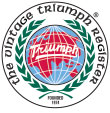Clutch Hose Problems
by Arthur Kelly, ArthurK101@aol.com
Sometimes the most obvious and simplest answer is the right one. Take the case of a clutch problem which lasted almost two years and did not get better by itself. (Even though I hoped that one morning it would just be “all better”).
The clutch in my TR4 (same configuration as TR2 and 3) was a little harder to engage and disengage than I remembered it being in the 1960’s and 70’s. I chalked that up to my poor memory or advancing age. Finally it became bad enough that I felt compelled to do something. I adjusted the clearance of the Clutch slave cylinder rod, but that did not help very much.
Time passed and I began to notice that not only was the clutch pedal hard but there was a lag between the time I came off the pedal and the time that the clutch became fully engaged. I could see this lag because the tachometer bounced as I applied throttle after releasing the clutch pedal.
I asked other members of my local Triumph club what they thought and received answers of: 1) The clutch master cylinder was bad (but it had been replaced the year before) 2) The clutch slave cylinder was bad and 3) The flexible hose between the two cylinders was bad. OK – now what? I hate to replace things that do not need to be replaced, not only for the expense but also because it is dumb. There are enough things which will need replacement without replacing unnecessary items. Of the three possibilities which was the correct one?
So I did an even dumber thing than ordering on or more of the parts – I sat paralyzed and I adjusted my driving to fit what was happening! No-one else was driving the car, so I just kept adjusting my gear change time. It got to the point where I was hesitating for 1 or 2 seconds before giving the accelerator a push after I had released the clutch pedal. That was lots of fun at traffic lights!
Then my brother, who had had a TR6 back in the early 70’s, came for a visit. He had not driven a TR in many years and so I let him drive it. He was pleased but said something about my clutch being “unnecessarily difficult to operate” (not quite in those words). I merely replied “you have to get used to it” but now realized what I had been doing.
Shortly after, when I took the car to a local mechanic to get some ideas about another problem, I mentioned the clutch problem. The mechanic reached down into the engine compartment in front of the left side of the fireball, stood up and said “That was easy – It’s the hose between the main and slave cylinders. It’s bad.” Period! (The hose, by the way, was soft; it is supposed to be hard enough so it doesn’t expand under pressure; and it was also seeping hydraulic fluid).
When I placed an order for the parts which were needed to fix that other problem, I had TRF send me a clutch slave cylinder hose. The hose cost under 10 dollars, and took 10 minutes to replace. The problem had been easy to detect and was something I should have picked up by myself. And that was it – Except that I had to completely readjust my driving back to normal! :-).
Why the story? I’m not unique – how many others of us are letting a problem continue by adapting to it rather than solving it? By the way – there are similar hoses on the brake hydraulic system. The same hose problem there could cause the brakes to lock up after being applied. So it’s a good practice to periodically check those flexible hoses in the both hydraulic systems.
Art Kelly 64 TR4 CT33118L (Original owner / daily driver)
VTR TR4 Vehicle Consultant
